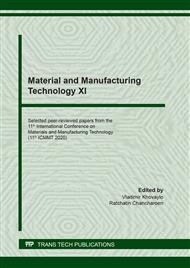[1]
W.H. Beck: Pyrolysis studies of polymeric materials used as binders in composite propellants: a review. Combust and Flame Vol. 70, Issue 2 (1987), p.171–190.
DOI: 10.1016/0010-2180(87)90077-0
Google Scholar
[2]
National aeronautics and space administration: Solid rocket motor nozzles. NASA space vehicle design criteria (Chemical propulsion), United States. (1975).
Google Scholar
[3]
X. Jia, Z. Zeng, G. Li, D. Hui, X. Yang and S. Wangd: Enhancement of ablative and interfacial bonding properties of EPDM composites by incorporating epoxy phenolic resin. Composites Part B: Engineering Vol. 54 (2013), pp.234-240.
DOI: 10.1016/j.compositesb.2013.05.005
Google Scholar
[4]
R. Vesna: Case Bonded System for Composite Solid Propellants. Scientific Technical Review, Vol.57. (2007).
Google Scholar
[5]
N.K. Nath and K.B. Dinesh: Performance evaluation of flex nozzle ablative liners by conducting solid rocket motor ground firing test. Journal of Manufacturing Engineering Vol. 12, Issue 4 (2017), pp.191-195.
Google Scholar
[6]
N.K. Nath and P. Mallesham: Development of Composite Ablative Liners For Solid Rocket Motor Flex Nozzles. Journal of Aerospace Sciences & Technologies Vol. 65 (2013), pp.254-261.
Google Scholar
[7]
L. Jiang, X. Kun, L. Xiang, L. Qiang, and W. Shu-xian: Characteristics and formation mechanism of compact/porous structures in char layers of EPDM insulation materials. Carbon Vol. 127 (2018), pp.498-509.
DOI: 10.1016/j.carbon.2017.10.091
Google Scholar
[8]
R. Marco, N. Maurizio and T. Luigi: An Introduction to Ablative Materials and High-Temperature Testing Protocols. Nanomaterials in Rocket Propulsion Systems. (2019), pp.529-549.
DOI: 10.1016/b978-0-12-813908-0.00014-9
Google Scholar
[9]
S.V. Balaji, C.C. Gary, P.K. Roy and A. Anahita: Computational Tools for Re-entry Aerothermodynamics: Part II. Surface Ablation, Aerospace Sciences Meeting and Exhibit, United States. (2008).
DOI: 10.2514/6.2008-1218
Google Scholar
[10]
G.P. Sutton: Rocket Propulsion Elements, 6th Edition, John Wiley & Sons. (1992).
Google Scholar
[11]
T.W Giants: Case-bond liner systems for solid rocket motors. Aerospace Corporation Report No.TR 0090 (5935-02), The Aerospace Corporation, California, USA. (1991).
Google Scholar
[12]
C.B. Haska, E. Bayramali, F. Pekel and O. Saim: Mechanical properties of HTPB-IPDI-based elastomers. Journal of Applied Polymer Science Vol. 64, Issue 12, (1997), pp.2347-2354.
DOI: 10.1002/(sici)1097-4628(19970620)64:12<2347::aid-app9>3.0.co;2-l
Google Scholar
[13]
S.D. Kakade, S.B. Navale, U.B. Kadarn and M. Gupta: Effect of Fillers and Fire Retardant Compounds on Hydroxy-Terminated Polybutadiene-Based Insulators. Defence Science Journal Vol. 51, No.2 (2000).
DOI: 10.14429/dsj.51.2213
Google Scholar
[14]
ASTM Designation E285-08: Standard Test Method for Oxyacetylene Ablation Testing of Thermal Insulation Materials. (2015).
Google Scholar


